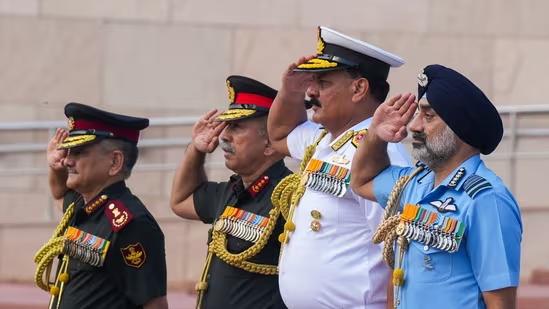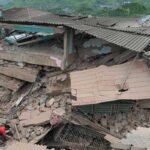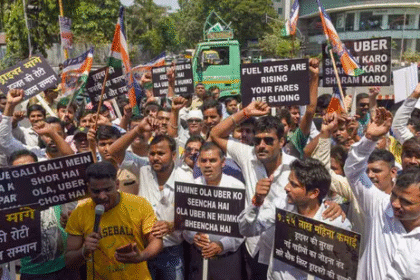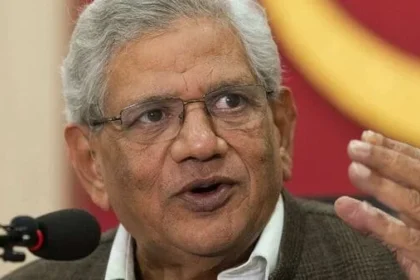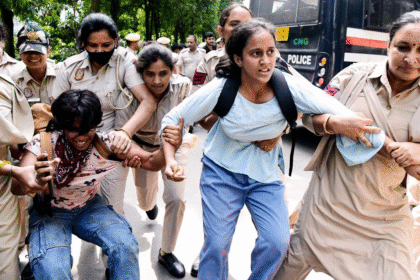Mumbai Rains: Lake Levels in City’s Seven Water Reservoirs Reach 88.81% Capacity
The Lifeline Rises – A Monsoon of Relief for Mumbai
The rhythmic sound of monsoon showers tapping against window panes is more than just a seasonal melody for Mumbai—it is the pulse of the city’s survival. With every spell of rain, the city watches its lakes rise with hope. And as of this week, Mumbai’s seven vital water reservoirs have reached an impressive 88.81% of their total storage capacity, signaling a crucial moment of reassurance for millions.
Water: Mumbai’s Most Precious Urban Currency
Mumbai may be India’s financial capital, but it still bows before one of nature’s simplest elements—water. Every year, the city’s 1.3+ crore residents are at the mercy of the monsoon to ensure they have enough drinking water for the months ahead. From early June to late September, all eyes are fixed on the sky, the civic dashboard, and the lake levels.
These lakes—Modak Sagar, Tansa, Bhatsa, Vihar, Tulsi, Upper Vaitarna, and Middle Vaitarna—form the backbone of the city’s water supply. Managed by the Brihanmumbai Municipal Corporation (BMC), they together store around 14.47 lakh million litres of water when at full capacity.
The news that they are nearly 89% full as of late July is not just a number—it is a story of reprieve, planning, unpredictability, and the balancing act of nature and infrastructure.
Monsoon 2025: A Season of Recalibrated Expectations
The 2025 monsoon season began with mixed signals. In early June, Mumbai received scattered rainfall, and by mid-month, the IMD (India Meteorological Department) had flagged a delayed but intense monsoon surge. Rains picked up dramatically in the first week of July, drenching the city in back-to-back spells of heavy downpour.
Localities like Andheri, Chembur, Dadar, and Kurla reported waterlogging, and the usual flood warnings were issued for low-lying areas, but the silver lining was clearer than ever—lakes were filling up faster than expected.
As of July 25, the seven reservoirs combined hold 12.86 lakh million litres of water—enough to comfortably sustain the city for several months ahead. This is in stark contrast to previous years when the same levels were reached only in August, sometimes barely before the monsoon receded.
Inside the Lakes: A Profile of Mumbai’s Water Guardians
Let’s break down the reservoir update to understand the magnitude:
- Bhatsa Lake, which provides over 50% of the city’s water, is near capacity. Its remote location in Thane district makes it heavily reliant on consistent rainfall in the catchment area.
- Modak Sagar and Tansa, both in Shahapur, are older reservoirs and have traditionally been the most stable contributors.
- Tulsi and Vihar, within Sanjay Gandhi National Park, serve South and Central Mumbai and are often the first to fill due to their smaller size.
- Upper Vaitarna and Middle Vaitarna, more recent additions to the lake network, have benefited from engineering upgrades and better monsoon runoff channels.
The combined 88.81% level is more than just encouraging—it sets a benchmark that the BMC and citizens can plan around.
A Civic Engineering Ballet: Behind the Scenes of Water Management
While nature fills the lakes, man must move the water. The BMC’s hydraulic department has the daunting task of ensuring smooth, uninterrupted distribution across Mumbai’s 24 municipal wards. The entire water supply chain involves:
- Pumping stations located at distances ranging from 30 to 140 kilometers from the city.
- Water treatment plants like Bhandup Complex, which process up to 2,100 million litres of water per day.
- A complex underground pipeline network, over a century old in places, that snakes its way into homes, housing societies, slums, hospitals, and corporate towers.
This entire system hinges on the levels of these reservoirs. When levels drop, as seen in 2014 and 2021, water cuts become inevitable, and the city turns to borewells, tankers, and even groundwater extraction—often unsustainable and ecologically damaging.
This year, however, things are different. With 88.81% storage already achieved in July, the BMC is not considering water cuts and may even review its reserve strategy to prepare for the post-monsoon dry season more effectively.
Why This Data Matters to Every Mumbaikar
Water statistics aren’t just the concern of urban planners—they affect everyone. When the reservoirs are full:
- Households receive their full water quota without interruptions or pressure issues.
- Hospitals and schools can plan resource usage better, without resorting to alternate water sources.
- Fire brigades and emergency services maintain reserve stock with confidence.
- Construction projects, usually affected by water rationing, move forward steadily.
- Low-income communities, especially in slums and chawls, face fewer challenges from water scarcity.
Additionally, the economic cost of water management reduces drastically. The BMC spends crores every year during drought conditions to deploy tankers, dig borewells, and import water from distant districts. This year’s rain bounty may save the civic body substantial funds that can be redirected elsewhere.
From Crisis to Cushion: Lessons from Past Years
It’s important to remember that just two years ago, in 2023, Mumbai faced a 19% water stock deficit in mid-July. Panic had set in. Housing societies received BMC notices for usage limits. Tankers increased dramatically. Public fountains were shut off, and gardens were asked to minimize irrigation.
That crisis triggered a review of water budgeting policies. The BMC, with guidance from the state government, began expanding catchment area conservation, promoting rooftop rainwater harvesting, and investing in non-revenue water (NRW) audits to reduce leakages.
This proactive policy environment has played a role in this year’s preparedness. While nature was generous, planning made the difference.
A City Briefly at Peace with Its Monsoon
The monsoon often brings Mumbai to its knees with floods, traffic paralysis, and washed-out daily life. But in this rare moment, it is also the city’s quiet saviour. With the lakes near full and water security on the rise, the people of Mumbai can breathe easier—at least for now.
Yet, questions remain: What happens if the rains stop early? How do we preserve this surplus? Can the city avoid complacency and build a water-secure future, year after year?
The Making of a Water-Smart Mumbai – Policies, Projects, and Pitfalls
Water security in Mumbai isn’t just about rainfall—it’s about readiness. With lake levels nearing full capacity due to abundant monsoon rains, the spotlight now shifts from nature’s generosity to the city’s preparedness. Can Mumbai convert this rainfall surplus into long-term sustainability? What systems are in place to manage, conserve, and distribute water efficiently? And most importantly, how does the city ensure that the pain of drought years is not repeated?
The answer lies in an evolving ecosystem of infrastructure, policy reforms, digital technology, public participation, and—at times—sheer improvisation. This part explores the steps Mumbai has taken, and must continue taking, to become a truly water-smart city.
Mumbai’s Thirst: A Data-Driven Wake-Up Call
Every day, Mumbai consumes nearly 3,800 million litres of water. This demand spans across:
- Residential households
- Commercial buildings
- Slums and informal settlements
- Government institutions and essential services
The BMC supplies over 3,750 MLD (million litres per day) through its lake-reservoir-treatment pipeline system. However, water losses due to leakage, theft, or inefficiency—classified as Non-Revenue Water (NRW)—remain a persistent issue. Estimates suggest Mumbai loses between 20–25% of its daily water to such factors.
Even in a year like 2025, where the lake levels are high, this inefficiency poses a challenge. A smart city cannot afford to treat water like a disposable resource.
From Quantity to Quality: Reimagining Urban Water Management
A few key shifts are already underway:
1. Digitization of Water Supply Networks
The BMC has started deploying SCADA (Supervisory Control and Data Acquisition) systems to monitor water flow, pressure, and leakage points in real-time. This allows engineers to remotely control valves, identify burst mains, and redirect flow instantly—saving thousands of litres per incident.
2. Smart Meters and Demand-Based Billing
Currently, much of Mumbai’s water billing is based on estimated consumption. Trials are underway in selected wards (like G-South and H-East) to install smart water meters that offer accurate, real-time usage data. These not only improve revenue recovery but also encourage responsible consumption.
3. Rooftop Rainwater Harvesting Mandate
BMC regulations now mandate rainwater harvesting systems in all new buildings over a certain area. In 2022, it also launched a retrofit incentive scheme, offering rebates in property tax for old housing societies that install harvesting systems.
Though implementation has been patchy, awareness is rising, and over 10,000 buildings reportedly have functional systems as of 2024.
4. Greywater Recycling in Mega Projects
High-rise residential townships and IT parks, particularly in Bandra-Kurla Complex, Powai, and Lower Parel, have installed greywater recycling plants. These systems treat used water from showers and sinks for reuse in landscaping, flushing, and cooling towers.
The Bottlenecks: What’s Holding the City Back
Despite the progress, Mumbai’s path to water resilience is hampered by several persistent issues:
➤ Ageing Infrastructure
Many of the city’s water pipelines are over 60 years old, made of cast iron or steel, prone to corrosion and leakage. The BMC’s plan to modernize this network has seen limited funding and inconsistent execution.
➤ Slum Access Inequality
Nearly 42% of Mumbai’s population lives in slums, where water access is irregular, rationed, and in some areas, still dependent on water tankers or illegal connections. Despite court rulings that slum dwellers have a right to water, execution remains politically and logistically difficult.
➤ Political Interference in Water Cuts
Water supply management becomes particularly sensitive during election seasons. Even when reservoirs are low, political pressure often prevents BMC from enforcing rational water cuts, leading to unsustainable extraction from lakes.
➤ Underutilization of Desalination and Reuse
Mumbai’s long-discussed desalination project at Manori, capable of generating 200 MLD of fresh water from the Arabian Sea, has seen delays due to cost concerns and environmental clearances. Meanwhile, treated sewage reuse—a practice common in global cities—is still in its infancy here.
Learning from Others: Global Models Mumbai Can Emulate
If Mumbai is to become water-secure, it must look beyond national boundaries for best practices.
- Singapore: Recycles over 40% of its sewage water into high-grade potable water through its NEWater initiative.
- Cape Town, South Africa: Nearly ran out of water in 2018, but successfully reversed the crisis through targeted rationing, public awareness campaigns, and emergency infrastructure.
- Los Angeles: Uses stormwater capture parks and green infrastructure to recharge aquifers.
In each case, the success stories came not from technology alone, but from collaborative governance, citizen engagement, and long-term political commitment—three ingredients Mumbai still struggles to balance.
Rain as a Blessing and a Warning
While this year’s rains have nearly filled the reservoirs, climate unpredictability looms over the horizon. Mumbai’s monsoon is becoming increasingly erratic—long dry spells followed by intense, short bursts of rainfall. This poses risks of both flooding and water shortages.
The Urban Climate Resilience Plan, proposed in 2023, aims to integrate lake management with flood control, aquifer recharge, and urban green spaces. However, its implementation hinges on coordination between multiple departments—water supply, stormwater drainage, environment, and urban planning—all of which often operate in silos.
Role of the Common Citizen: Water Begins at Home
A water-smart Mumbai cannot rely on governance alone. Citizens must be active partners in conservation. Small but impactful practices include:
- Fixing leaking taps or toilets (saving up to 500 litres/month).
- Reusing RO wastewater for mopping or gardening.
- Timing showers and avoiding excessive water use during brushing or dishwashing.
- Encouraging societies to install dual plumbing systems for greywater reuse.
Campaigns like “Pani Bachao, Mumbai Banao” have begun engaging students and RWAs (Resident Welfare Associations), but long-term behavioural change remains the challenge.
A Future Written in Drops
The sight of 88.81% lake levels should not be a cue for celebration alone—it should be a call to action. This surplus must not be squandered. Instead, it must inspire a movement—a conscious shift towards smarter water management, infrastructural investment, and civic responsibility.
Mumbai stands at a crossroads: continue reacting to the monsoon, or lead the way in building a self-reliant, water-secure future. The rain has done its job. Now, the city must do its part.
When we talk about Mumbai’s water supply, names like Modak Sagar, Tansa, Upper Vaitarna, and Bhatsa are often mentioned. These lakes and reservoirs are celebrated during monsoons when water levels rise, and dreaded during drought years when they dip dangerously. But what’s rarely discussed is how these lakes are sustained, the ecological networks behind them, and the invisible rivers, forests, and watersheds that act as Mumbai’s natural water infrastructure.
This part examines Mumbai’s hydrological ecosystem—from forest catchments and tributaries to upstream communities and climate vulnerabilities—and why protecting them is vital to securing the city’s future water needs.
Mumbai’s Water Lakes: More Than Just Reservoirs
Mumbai’s seven main lakes/reservoirs supplying potable water include:
- Tulsi Lake
- Vihar Lake
- Modak Sagar (Lower Vaitarna)
- Tansa Lake
- Upper Vaitarna
- Bhatsa Dam
- Middle Vaitarna
Together, they supply over 3,750 million litres per day (MLD) of water to Mumbai. But these reservoirs are not standalone tanks. They’re interlinked hydrological systems that depend on rainfall, forest catchments, feeder streams, and upstream ecosystems.
The Catchment Ecosystems: Mumbai’s Real Water Factories
Let’s consider a few examples:
🟢 Tansa and Modak Sagar
These lakes lie in Thane district, surrounded by dense deciduous forests in the Tansa Wildlife Sanctuary. These forests act as natural sponges—absorbing rainfall, slowing runoff, and gradually releasing water into the lake systems. Deforestation, quarrying, and road expansion in this region threaten the integrity of the catchment.
🟢 Upper and Middle Vaitarna
These lakes are part of the Western Ghats, one of the world’s most critical biodiversity hotspots. Their surrounding areas in Nashik and Palghar districts receive high rainfall, but soil erosion and land-use changes—particularly from commercial farming and encroachments—have led to silting and runoff problems.
🟢 Tulsi and Vihar Lakes
Located within Sanjay Gandhi National Park (SGNP), these two lakes are the oldest sources of water for Mumbai. Despite their limited capacity today, they serve as a symbol of urban-forest coexistence. However, they’re now facing pollution threats from sewage, plastic litter, and encroachment from nearby settlements.
The River Systems: Dying Arteries of Mumbai’s Water Landscape
Mumbai was once crisscrossed by over a dozen riverine systems, including:
- Mithi River
- Dahisar River
- Poinsar River
- Oshiwara River
- Mahul Creek
- Ulhas River Basin (outside city)
Today, most of them are polluted, narrowed, and channelized, treated as stormwater drains rather than living ecosystems.
➤ Mithi River, for example, which connects Powai Lake and Mahim Creek, is choked with industrial effluents and untreated sewage. The river once played a vital role in groundwater recharge and helped maintain ecological flows toward the coast.
➤ Ulhas River feeds into Bhatsa Dam, which supplies over 50% of Mumbai’s daily water. This river passes through several towns that dump sewage and untreated industrial waste into it. In 2023, parts of Ulhas were declared ‘severely polluted’ by the Central Pollution Control Board (CPCB).
How Ecosystem Decline Impacts Water Supply
- Deforestation reduces rainfall retention, increases runoff, and lowers groundwater recharge.
- Silting in catchments reduces effective lake capacity.
- Pollution in rivers and reservoirs makes treatment costlier and sometimes inadequate.
- Encroachments and construction block natural drainage patterns, increasing flood risk and reducing aquifer recharge.
Traditional Wisdom Lost: The Indigenous Guardians of Watersheds
Tribal communities in the Western Ghats and Adivasi hamlets of Thane, Palghar, and Nashik have traditionally lived in harmony with water sources. They maintained sacred groves, practiced sustainable forest harvesting, and understood seasonal water cycles intimately.
But modernization, displacement due to dam projects, and lack of recognition have eroded these traditional systems. Activists have long argued that involving these indigenous communities in catchment management—through employment, co-governance, and benefit-sharing—can improve conservation outcomes significantly.
Policy Gaps and Missed Opportunities
Despite the ecological stakes, Mumbai’s water policy is largely engineering-driven. It focuses on:
- Dams
- Pipelines
- Treatment plants
- Leak management
But there’s little emphasis on ecosystem services such as:
- Wetland protection
- Forest regeneration
- River rejuvenation
- Sustainable farming upstream
Only recently has the BMC begun to consider Nature-Based Solutions (NBS), such as:
- Constructed wetlands
- Urban forest patches
- Permeable paving systems
- Decentralized stormwater recharge
However, these remain pilot efforts and lack dedicated funding or legislative backing.
Climate Change: The Final Threat to the Lake Ecosystem
Climate models suggest that by 2030, Mumbai could experience:
- Shorter, more intense monsoon periods
- Longer dry spells in winter
- Increased urban flooding
- Higher evaporation rates from lakes
If upstream ecosystems are not protected, the city could suffer both flood and drought in the same season—a situation already witnessed in parts of Karnataka and Tamil Nadu.
Way Forward: A Blueprint for Eco-Hydrological Resilience
1. Legally Protect All Lake Catchments
Classify them as Eco-Sensitive Zones (ESZs), with clear buffer zones, anti-deforestation rules, and community involvement.
2. Invest in River Rejuvenation
Treat rivers like Mithi and Dahisar as urban ecological assets, not drains. This means restoring their width, flow, floodplains, and biodiversity.
3. Decentralize Water Governance
Empower local bodies, housing societies, and citizen groups to manage greywater, harvest rain, and recharge aquifers—reducing dependency on distant lakes.
4. Public-Private Partnerships for Ecosystem Revival
Leverage CSR funds from industries and tech companies to fund reforestation, cleanup, and water audits in upstream districts.
5. Educate and Involve the Public
Campaigns like “Know Your Lake” or “Adopt a River” can create emotional ownership, especially among school students and housing societies.
Reconnecting the City to Its Source
Mumbai’s relationship with water is dangerously one-sided. We pump billions of litres daily from distant forests, yet seldom think about what sustains those sources. Lakes do not fill themselves. They rely on forests, rivers, animals, clouds, and communities—a delicate dance of ecology that deserves reverence, not exploitation.
If Mumbai wants secure, clean, and equitable water for decades to come, it must reconnect with its forgotten ecosystems. Because every drop that reaches your tap has travelled hundreds of kilometres, through forests, rivers, and sometimes the efforts of generations past.
Let us honour that journey.
Also Read : Kargil Vijay Diwas: India Pays Tribute to Soldiers’ Unparalleled Courage and Sacrifice


